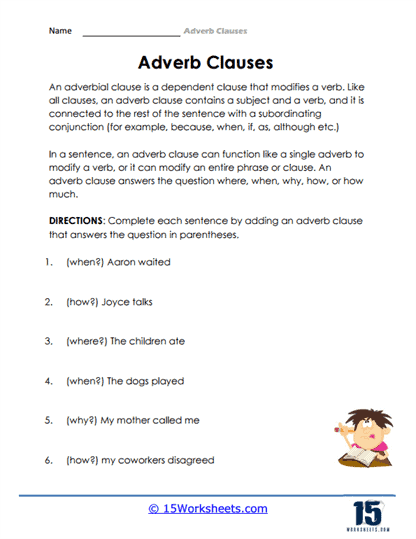

These adverb clauses worksheets aim to help students understand the concept of adverb clauses and how they function in sentences. The worksheets cover a wide range of topics related to adverb clauses, including identifying and using different types of adverb clauses, understanding how adverb clauses modify verbs, adjectives, and adverbs, and learning how to construct complex sentences using adverb clauses.
Through answering these worksheets, students will be able to:
An adverb clause is a group of words that functions as an adverb in a sentence. It contains a subject and a predicate and modifies a verb, adjective, or another adverb in the independent clause.
Adverb clauses are an important part of the English language and can add depth and complexity to a sentence. Here are some additional points about adverb clauses that are important for students to learn before answering these worksheers:
In summary, adverb clauses are a type of dependent clause that can modify verbs, adjectives, and other adverbs in a sentence. They are introduced by subordinating conjunctions and can add depth, complexity, and precision to a sentence. Understanding the types and placement of adverb clauses can help students to use them effectively in their writing and communication.
When you have several words in a sentence that serve the function of an adverb, we refer to that phrase as an adverbial clause or adverb clause, for short. Just like an adverb, those words can, either describe or modify a verb, adjective, or a different adverb. To be a complete clause it must contain a subject and a verb. These are not to be confused with adverb phrase that lack either a subject or a verb. These clauses usually provide the reader with more factual information focus on the action that is taken place within the sentence. They often begin with a subordinating conjunction (although, after, because, if). This series of worksheets will help student become comfortable with identifying, placing, and writing with the use of adverb clauses.
Proper Use of Adverb Clauses
These clauses are very versatile as far as their placement within a sentence. They can be placed at the front, end, or even middle of the sentence. It all depends on which sounds best and lets the message flow the best. They can often provide that extra detail or important fact for our readers. They can be a little more complicated to use than your standalone adverbs but can add rich and vivid detail when used properly.
As we discussed earlier, when we introduced this concept, there are three general conditions which constitute adverb clauses:
Start of Sentence Placement – When we use adverb clauses at the front of a sentence they are followed by comma. These types of placements are often used to explain the cause for an expected outcome or reason behind why an action took place. Take a look at these two examples:
If you forget to pay your bill, they will shut off your phone.
Before we go to the restaurant, we need to make a reservation.
Middle of Sentence Placement – This trend with commas continues on. When you use an adverb clauses in the middle of a sentence it found between two commas. We use these placements to add detail or interrupt the main thought or purpose of the sentence. Here are two examples for you to take in:
Beth, although she is smart, failed the test.
My brother, when he is angry, grinds his teeth.
End of Sentence Placement – When used at the end of a sentence adverb clauses do not require any additional punctuation. This type of placement is often used to explain how something occurred. Here are two examples:
You need to prepare for the test even if no one else plans to.
The day flew by because I was constantly busy.
Adverb clauses are important for students to learn, mainly for the following reasons:
In summary, learning about adverb clauses is important for students who want to improve their writing skills and communicate more effectively.